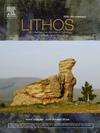Petrogenesis and tectonic implications of Paleozoic S-type granitic gneisses of Nanga Parbat Syntaxis, North Pakistan
IF 2.9
2区 地球科学
Q2 GEOCHEMISTRY & GEOPHYSICS
引用次数: 0
Abstract
This study integrates in-situ zircon U-Pb and Hf isotope data, and whole-rock geochemical analyses, along with field and petrographic features of granitic gneisses exposed in the Nanga Parbat Syntaxis. The aim is to constrain the petrogenesis and tectonic evolution of these rocks. Field and petrographic observations distinguish the studied rocks into two varieties: leucogranitic gneisses referred as type 1 and augen gneisses referred as type 2. Zircon U-Pb dating of type 1 yields a weighted mean age of ∼460 Ma while type 2 yields an age of ∼480 Ma, indicating that both types were emplaced during the early Paleozoic. Geochemically both types are strongly peraluminous, high-K calc-alkaline, and show high normative corundum, indicating an S-type granite magma source derived from the anataxis of heterogeneous supracrustal metasedimentary rocks. The highly negative εHf(t) values (−29.5 ∼ −8.8) further confirm types 1 and 2 rocks were derived from crustal material without a significant contribution from the mantle. Type 1 rocks are characterized by the presence of tourmaline, high Al2O3/TiO2 (67.3–84.2), and low CaO/Na2O (0.25–0.37) ratios, suggesting their formation through the partial melting of boron-rich metapelites under moderate temperatures (avg. 763 °C, based on Ti-in-zircon thermometry). In contrast, type 2 rocks lack tourmaline, show higher CaO/Na2O ratios (0.60–0.70), lower Al2O3/ TiO2 ratios (19.3–23.9), and are likely formed from hydration-driven partial melting of metagraywacke at an average temperature of ∼704 °C. The geochemical and isotopic data in this paper, and their comparison with coeval rocks from the Himalaya and other regions, suggest that magma of the studied Paleozoic granites originated from heterogenous metasedimentary sources, likely deposited in a back-arc basin followed by the subduction of the Proto-Tethyan Oceanic lithosphere, followed by slab roll-back and break-off. Such a tectonic setting possibly triggered mafic magmatic underplating and induced partial melting of the back-arc assemblages. Both rock types contain occasionally inherited zircon cores that yield ages of ∼2065 to ∼773 Ma, indicating remnants of earlier crustal growth events. Additionally, a few zircon grains with ages of ca. 53 and 25 Ma could be linked with the Cenozoic India-Asia collision-related magmatism, metamorphism, and post-collision anataxis.
巴基斯坦北部Nanga Parbat构造带古生代s型花岗质片麻岩成因及其构造意义
本研究结合现场锆石U-Pb和Hf同位素数据、全岩地球化学分析以及南加帕尔巴特构造中暴露的花岗质片麻岩的野外和岩石学特征。目的是限定这些岩石的岩石成因和构造演化。野外和岩石学观察将所研究的岩石分为两类:白花岗质片麻岩(1型)和长须岩(2型)。类型1的加权平均年龄为~ 460 Ma,而类型2的加权平均年龄为~ 480 Ma,表明这两种类型的就位时间都在早古生代。地球化学特征均为强过铝质、高钾钙碱性、高规范刚玉,为源自非均质壳上变质沉积岩的s型花岗岩岩浆源。高负的εHf(t)值(- 29.5 ~ - 8.8)进一步证实了1型和2型岩石来源于地壳物质,没有明显的地幔贡献。1型岩石以电气石为主,Al2O3/TiO2比值高(67.3 ~ 84.2),CaO/Na2O比值低(0.25 ~ 0.37)为特征,表明它们是在中等温度(平均763℃,根据ti -in-锆石测温)下由富硼变长岩部分熔融形成的。相比之下,2型岩石缺乏电气石,CaO/Na2O比值较高(0.60 ~ 0.70),Al2O3/ TiO2比值较低(19.3 ~ 23.9),可能是在平均温度~ 704℃的水化作用下形成的。本文的地球化学和同位素资料,以及与喜马拉雅和其他地区同年代岩石的对比表明,所研究的古生代花岗岩的岩浆起源于非均质变质沉积岩,可能沉积于弧后盆地,然后是原特提斯洋岩石圈的俯冲,然后是板块回滚和断裂。这样的构造环境可能触发了基性岩浆底沉积,诱发了弧后组合的部分熔融。这两种岩石类型都含有偶尔继承的锆石核,产生的年龄为~ 2065 ~ ~ 773 Ma,表明早期地壳生长事件的残余。此外,少数年龄约为53 ~ 25 Ma的锆石颗粒可能与新生代印度-亚洲碰撞相关的岩浆作用、变质作用和碰撞后的成岩作用有关。
本文章由计算机程序翻译,如有差异,请以英文原文为准。
求助全文
约1分钟内获得全文
求助全文
来源期刊

Lithos
地学-地球化学与地球物理
CiteScore
6.80
自引率
11.40%
发文量
286
审稿时长
3.5 months
期刊介绍:
Lithos publishes original research papers on the petrology, geochemistry and petrogenesis of igneous and metamorphic rocks. Papers on mineralogy/mineral physics related to petrology and petrogenetic problems are also welcomed.
 求助内容:
求助内容: 应助结果提醒方式:
应助结果提醒方式:


